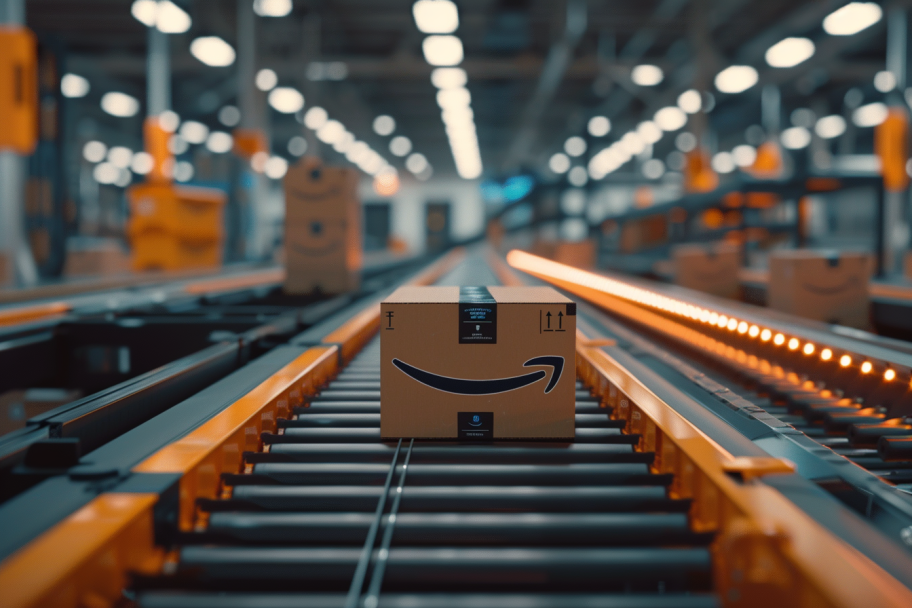Amazon’s FBA (Fulfillment by Amazon) business model is a popular choice for many sellers in the ecommerce industry. It offers a range of benefits and opportunities, but also comes with its own set of challenges. In this article, we will take a closer look at the basics, inner workings, pros and cons, financial aspects, and policies of Amazon FBA. Whether you are considering starting your own FBA business or simply curious about this model, we hope to provide you with valuable insights and guidance.
The Basics of Amazon’s FBA Business Model
Before we examine the details of Amazon FBA, it’s important to understand what it actually entails. Amazon’s Fulfillment by Amazon (FBA) service has changed the way e-commerce businesses operate, offering a seamless and efficient solution for order fulfillment.
When sellers opt to use Amazon FBA, they are essentially leveraging Amazon’s extensive logistics network to store, pack, and ship their products. This hands-off approach allows sellers to focus on growing their business and expanding their product offerings, rather than getting bogged down in the details of order processing and shipping logistics.
What is Amazon FBA?
Amazon FBA stands for Fulfillment by Amazon. In simple terms, it means that Amazon takes care of storage, packaging, and shipping of products on behalf of sellers. Sellers send their inventory to Amazon fulfillment centers, and when a customer places an order, Amazon handles the entire fulfillment process. This allows sellers to focus on other aspects of their business without the hassle of order fulfillment.
By partnering with Amazon FBA, sellers gain access to Amazon’s world-class fulfillment infrastructure, including state-of-the-art warehouses, advanced inventory management systems, and expedited shipping options. This not only streamlines the order fulfillment process but also enhances the overall customer experience, leading to higher satisfaction rates and repeat business.
Key Features of Amazon FBA
Amazon FBA offers several key features that make it an attractive option for sellers:
- Prime Eligibility: By utilizing FBA, sellers can make their products eligible for Amazon Prime membership, which significantly increases their visibility and chances of making sales.
- Customer Service: Amazon handles customer inquiries, returns, and refunds, reducing the burden on sellers and ensuring a positive customer experience.
- Global Reach: FBA allows sellers to reach customers not only within their own country but also internationally, thanks to Amazon’s vast network of fulfillment centers worldwide.
Amazon FBA also provides sellers with access to Amazon’s renowned customer service team, who are available around the clock to assist with any issues or concerns that may arise. This level of support is invaluable for sellers looking to provide top-notch service and build a loyal customer base.
The Inner Workings of Amazon FBA
Now that we have a grasp of the basics, let’s explore how Amazon FBA works behind the scenes.
Amazon FBA, or Fulfillment by Amazon, is a service provided by the e-commerce giant that allows sellers to store their products in Amazon’s fulfillment centers. This service simplifies the selling process for merchants by handling various aspects of order fulfillment, customer service, and logistics.
How Does Amazon FBA Work?
When a seller signs up for Amazon FBA, they send their products to Amazon’s fulfillment centers. Upon arrival, Amazon takes care of the storage, inventory management, and order fulfillment. When a customer places an order, Amazon picks, packs, and ships the product on behalf of the seller. Additionally, FBA handles customer service and manages returns and refunds, providing sellers with peace of mind.
One of the key advantages of using Amazon FBA is the Prime badge eligibility. Products fulfilled through FBA are often eligible for Amazon Prime, which can lead to increased visibility, faster shipping times, and higher conversion rates. This can be a significant competitive advantage for sellers looking to attract more customers and boost sales.
The Role of Inventory in Amazon FBA
Accurate inventory management is critical for a successful FBA business. Sellers need to ensure that they have enough stock available to meet customer demand. Amazon provides tools and reports to help sellers track their inventory levels and forecast future needs. You need to maintain a healthy balance between stocking enough inventory to fulfill orders promptly and avoiding overstocking, which can tie up valuable resources.
Moreover, Amazon FBA offers multi-channel fulfillment options, allowing sellers to fulfill orders from other sales channels, not just Amazon. This flexibility enables sellers to expand their reach and streamline their operations by centralizing their fulfillment processes through Amazon’s network of warehouses.
The Pros and Cons of Using Amazon FBA
Like any business model, Amazon FBA comes with its fair share of advantages and disadvantages.
Advantages of Amazon FBA
There are numerous benefits of choosing Amazon FBA for your ecommerce business:
- Time and Effort Savings: By outsourcing fulfillment to Amazon, sellers can focus on growing their business, sourcing new products, and marketing. This allows entrepreneurs to allocate their time and resources strategically, ultimately leading to business expansion and increased profitability.
- Access to Prime Members: With FBA, sellers can tap into Amazon’s massive Prime membership base, reaching a larger and more loyal customer audience. This access to Prime members provides a significant advantage, as these customers are more likely to make repeat purchases and trust the fulfillment process.
- Improved Customer Trust: Amazon’s reliable shipping and customer service enhance the overall shopping experience, boosting customer confidence in your brand. When customers have a positive experience with timely deliveries and excellent customer support, they are more likely to leave positive reviews and recommend your products to others.
Disadvantages of Amazon FBA
While Amazon FBA offers significant advantages, it’s important to consider the potential drawbacks as well:
- Fees and Costs: Utilizing Amazon’s fulfillment service comes at a cost. Sellers must account for storage fees, picking and packing fees, and other expenses when calculating their profit margins. However, it’s crucial to analyze these costs against the benefits gained from increased sales and improved customer satisfaction.
- Loss of Control: Relying on Amazon for order fulfillment means relinquishing control over certain aspects of the process, such as packaging and shipping speed. While Amazon has strict guidelines to ensure consistency, some sellers may prefer to have more control over these aspects to align with their brand image and customer expectations.
- Competition: With the popularity of FBA, competition from other sellers within the marketplace may increase, requiring sellers to differentiate their offerings and optimize their listings to stand out. However, this increased competition can also be seen as an opportunity to innovate, improve product quality, and provide exceptional customer service to gain a competitive edge.
Considering these advantages and disadvantages, it’s important to evaluate your business goals, resources, and target market before deciding whether Amazon FBA is the right choice for your ecommerce venture. By carefully weighing the pros and cons, you can make an informed decision that aligns with your long-term business strategy.
It’s also important to stay updated on any changes or updates in Amazon’s policies and fees to ensure that your business remains profitable and competitive in the ever-evolving ecommerce landscape. Continuous evaluation and adaptation are key to success for selling online.
Financial Aspects of Amazon FBA
To make informed decisions about your FBA venture, it’s crucial to understand the financial aspects involved.
When analyzing the financial realm of Amazon FBA, it’s essential to consider not only the fees associated with the service but also the potential for growth and scalability. By analyzing the cost structure and revenue streams of your FBA business, you can gain valuable insights into its long-term sustainability and profitability.
Understanding FBA Fees
Amazon charges various fees for using FBA services, such as storage fees based on the size and duration of inventory storage, fulfillment fees for each order picked, packed, and shipped, and additional fees for optional services like labeling or removal of inventory.
It’s important for FBA sellers to carefully track and manage these fees to ensure they are optimizing their cost structure and maximizing profitability. By understanding the breakdown of fees and strategically planning inventory management, sellers can minimize unnecessary expenses and enhance their bottom line.
Profitability and Revenue Potential
While the financial viability of an FBA business depends on factors such as product selection, pricing, and competition, many sellers find success with this model. By optimizing their listings, managing inventory effectively, and employing marketing strategies, sellers can create a profitable and sustainable business.
Exploring additional revenue streams within the Amazon ecosystem, such as Amazon Advertising or Amazon Brand Registry, can provide FBA sellers with opportunities to boost their revenue and expand their customer reach. Diversifying income sources and staying abreast of industry trends are key strategies for maximizing profitability in the competitive FBA landscape.
Navigating Amazon FBA Policies and Requirements
Becoming familiar with Amazon FBA policies and meeting the necessary requirements is essential for achieving success on the platform. Whether you’re a seasoned seller or just starting out, understanding the ins and outs of FBA can make all the difference in your ecommerce journey.
Amazon FBA Policies
Amazon has specific policies in place to ensure a consistent and positive experience for customers. These policies cover a wide range of areas, including product condition, restricted categories, intellectual property rights, and shipping requirements. By adhering to these policies, sellers can maintain a high level of customer satisfaction and avoid potential penalties or account suspensions.
For example, when it comes to product condition, Amazon expects sellers to accurately describe the condition of their items. This means providing clear and detailed information about any imperfections or wear and tear. By doing so, sellers can build trust with customers and reduce the likelihood of returns or negative feedback.
In addition, sellers must be aware of restricted categories, which are product categories that require additional approval from Amazon. These categories often involve products that have specific regulations or safety concerns. By understanding these restrictions and obtaining the necessary approvals, sellers can expand their product offerings and reach a wider customer base.
Seller Requirements for Amazon FBA
Before using FBA, sellers must meet certain requirements to ensure a smooth selling experience. These requirements include having an active professional selling account, adhering to Amazon’s performance metrics, and following product-specific guidelines.
Having an active professional selling account is the first step towards using FBA. This type of account allows sellers to access a range of features and benefits, including the ability to sell in multiple categories and access to Amazon’s advertising tools. It’s important to note that there are fees associated with a professional selling account, so sellers should carefully consider the financial implications before upgrading.
Sellers must maintain a high level of performance to remain in good standing with Amazon. This involves meeting certain metrics, such as order defect rate, late shipment rate, and pre-fulfillment cancel rate. By consistently meeting these metrics, sellers can demonstrate their commitment to providing a positive customer experience and increase their chances of winning the Buy Box.
Lastly, sellers must also adhere to product-specific guidelines. These guidelines vary depending on the category and type of product being sold. For example, sellers of electronics may need to provide additional information about product warranties or certifications. By familiarizing themselves with these guidelines and ensuring compliance, sellers can avoid potential issues and provide accurate information to customers.
Understanding Amazon’s FBA business model is vital for anyone looking to enter ecommerce. By leveraging the benefits of FBA, sellers can streamline their operations, tap into Amazon’s vast customer base, and focus on growing their business. However, it’s important to consider the challenges and financial aspects associated with FBA to make informed decisions and increase your chances of success. Stay informed on Amazon’s policies and requirements, and keep adapting and refining your strategies to thrive in the ever-evolving world of ecommerce.
Transform Your Inventory with Finale
Request a Free consultation (valued at $2,500) and let us tackle solving your biggest inventory management challenges with Finale Inventory and experience the difference Finale Inventory can make for your business.






